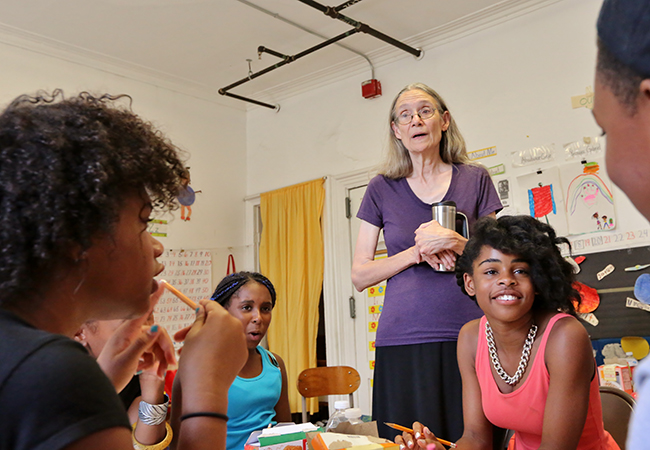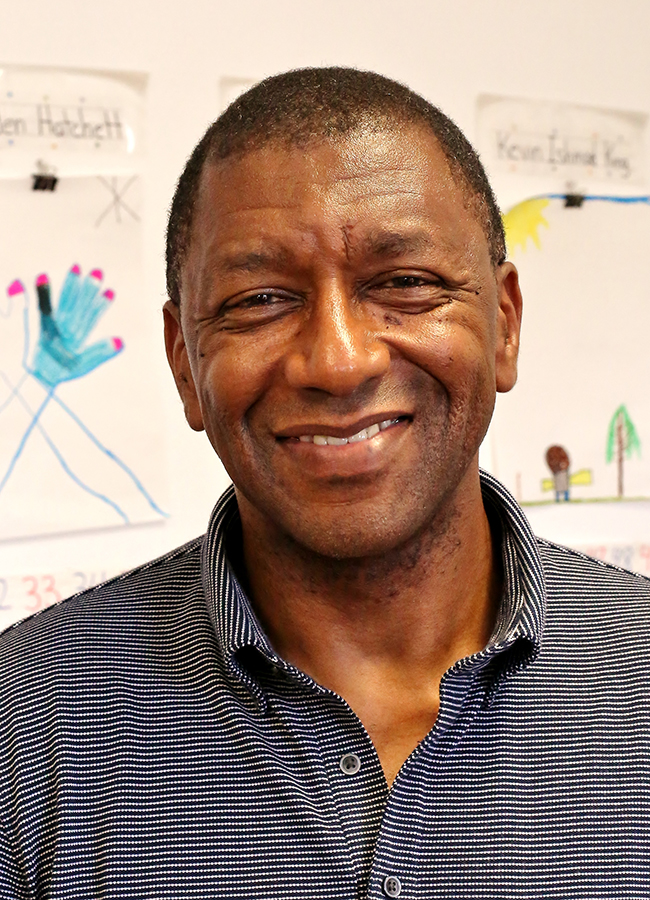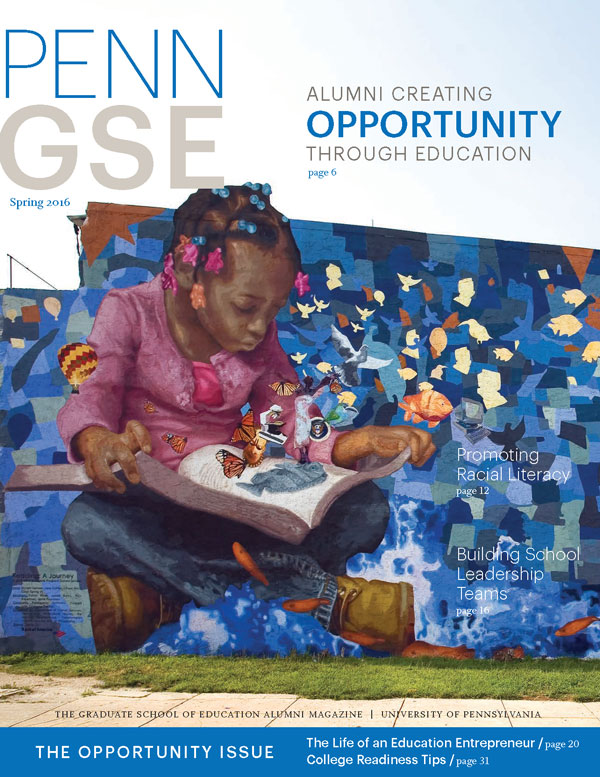Facing the Moment: Professor Howard Stevenson on Managing Racial Conflict Through Racial Literacy
interview by Juliana Rosati
When racial differences are stigmatized or poorly addressed in the classroom, learning and the opportunities it brings are jeopardized. A painful moment may reverberate in the mind of a student or teacher for years to come. Recognizing this, more than one hundred public and independent schools and community health organizations across the country have sought the expertise of Penn GSE’s Dr. Howard C. Stevenson, Constance Clayton Professor of Urban Education and Professor of Africana Studies. A clinical and consulting psychologist, Dr. Stevenson trains students and educators in racial literacy—the skills to identify and resolve racially stressful social interactions. We sat down with him to discuss the power of employing racial literacy in classrooms and beyond.
What is racial literacy, and why is it important?
Racial literacy is the ability to read and recast, or reduce and resolve, racially stressful encounters during face-to-face interactions. In general, people get overwhelmed, tongue-tied, and confused during racial conflicts, whether perceived or actual. They lose access to memory, stutter, and feel defensive and threatened. My team and I train people how to better respond, without overreacting or underreacting. We think this is the best place to begin addressing race-related inequities. Efforts to dismantle systemic racism through legal means are important, but they don’t help people of color to cope with the emotions of racial trauma, and they don’t address how people in positions of authority should manage their behavior when they feel racially threatened.
How do you define a racial encounter?
It’s really in the eye of the person involved. The range of what people consider a racially stressful moment varies tremendously. The conflict could be internal—you could be struggling with thoughts of what might happen in the presence of a person different from yourself. Or you could feel that you have been slighted or insulted because of your difference. Our work focuses on the conflicts that may arise in classrooms between students, or between students and teachers, and disrupt learning.
“Through debating and role-playing, we work with students to identify their fears and come up with healthy, assertive responses to the situation.”
We want them to benefit in terms of both health and academic performance. We know that men and women who experience racism have a host of health risks, from high blood pressure to breast cancer to lower life expectancy. These risks seem to be related to chronic stress that disrupts sleep habits over time. Any kind of stress can have these effects, but racial stress tends to be something people don’t talk about. We also know that students who worry about discrimination may not feel as smart as other students. If you feel that your difference, racial or otherwise, is stigmatized, it’s harder to pay attention in class, persist at difficult tasks, and motivate yourself to be fully engaged. Over time, this leads to decreased academic performance.
What are some of the key skills of racial literacy?
Our overarching strategy is stress management and relaxation. We ask people to “calculate, locate, and communicate” when they are in an encounter. “Calculate” means to identify, on a scale of one to ten, how stressed you are in the moment. “Locate” means to pinpoint where in your body you feel the stress, the more specifically the better. “Communicate” means to recognize any self-talk that you may be doing during the experience. You could be thinking something negative like, “I can’t handle this,” or something positive like, “I know I can work my way through this.” During these three steps, we also want people to breathe and exhale consciously. All of this is aimed at reducing stress quickly, ideally within sixty seconds. In threatening moments, people’s brains go into lockdown. The more you can relax, the more you can access what you know. When you feel less overwhelmed, your decision-making opportunities become much clearer.
What do you do in your workshops with children of color?

Photos by Darryl W. Moran Photography.
What are some examples of the responses students practice with you?
One student was interested in French, but she felt that because of her race the French teacher wasn’t engaging with her. The student withdrew from the class to the point that she was willing to take an F. We taught her enough French to speak in the language when asking for help, thinking that this could impress the teacher and change the nature of their engagement. The student was surprised by the teacher’s positive response. We want teachers to have the racial literacy training that would prevent situations like this, but we also want students of color to have the skills to persist in being learners even if an educator doesn’t understand them. In some situations, we work with students to practice what we call “healthy racial comeback lines.” The chronic stress associated with discrimination comes partly from not knowing what to say in the moment, and then worrying afterwards about what you should have done. It’s not just that you experienced a moment of rejection; it’s that you didn’t have any response to it, and that lingers in your mind and heart. The comeback could be as simple as saying “Excuse me?” with attitude in response to an insult from a classmate. Or it could be more elaborate. One student came up with a brilliant five-minute soliloquy to say in response to being called the n-word. It was about the history of the word, and spoken quickly so that the other person had no time to interrupt. The purpose is to empower students with a way to stand up for themselves; they don’t have to use the comeback if it doesn’t feel right. I tell students, “You don’t have to say it. You have to practice it well so that you have a choice as to whether to say it or not.”
You also train teachers and administrators in racial literacy. What do you hope they will gain?
We use the same relaxation and self-awareness techniques to help educators recognize the emotional consequences around facing difference in the world. We want them to develop the tools to address rather than ignore racial encounters that may occur between students and with teachers in their classrooms. We also want them to practice racial mindfulness so that they are aware of how they behave in the presence of people different from themselves.

Do you think such training could benefit people in other fields?
Yes. We think that a lot of the conflicts we’re seeing in the news between police and young people of color are situations where the police are incorrectly interpreting the level of threat as endangering their lives. It’s ironic that police are trained in how to de-escalate situations, but in so many of these cases, you see that even with that training, the first-level or mid-level attempts to de-escalate have not been used. There should be police training specifically about the skills of racial mindfulness and self-awareness. Your job as a police officer is to protect and serve. Why would that somehow be suspended when you’re in the presence of Black or Latino youth?
Racial conflict in higher education has been receiving increased attention due to the recent student protests at the University of Missouri and Yale University. What have you observed about these conflicts?
I think universities are underprepared to understand how racial trauma is perceived and experienced by students of color. Over time, these traumas build up, and these student protesters are saying that they’re not willing to wait until after graduation to deal with the impact of this. If a school has a mission of inclusiveness, but it hasn’t tied any particular goals to it—such as greater diversity, support for students of color, or racial conflict management training for faculty—then it’s just a symbolic statement. Students are saying that this isn’t good enough anymore.
You are launching a center at Penn GSE called the Racial Empowerment Collaborative. How will it take forward your work on racial literacy?
We will continue our workshops for students and educators, and launch a number of new initiatives. Postdoctoral Fellow Dr. Kelsey Jones, GR’15, and our research team are developing a children’s magazine called Reflections to share the voices of children who have experienced racial trauma and help students to overcome these issues. Another new project, called EMBRace, is led by Postdoctoral Fellow Dr. Riana Anderson. EMBRace will teach parents of color how to manage the stress of having conversations about race with their children. Eventually we would like to develop a similar program for white parents.
We’ll also be looking for ways to connect our efforts to the work of Dr. Constance Clayton, GRD’81. I am honored to hold the Penn GSE faculty chair in her name. She was the first woman and first African American Superintendent of Schools in Philadelphia, and has always been an advocate for children. She also advocates for the ways in which art with racial themes can educate the world, and the Philadelphia Museum of Art recently established the Constance E. Clayton Fellowship in her honor.
Why are the skills of racial literacy often underdeveloped?
Most people are afraid to talk about race. There are very few issues that people are so generally phobic to bring up. I think this is mostly because if it doesn’t go well, you’re going to feel uncomfortable, incompetent, and targeted. The most powerful coping strategy is to distract or be silent and hope that racial conflicts go away. But if people didn’t avoid these issues, they could gain much more practice and confidence in dealing with them. With the skills of racial literacy, educators and students can improve school climates, strengthen relationships among teachers and students, and foster emotional and academic well-being.
This article originally appeared in the Spring 2016 issue of The Penn GSE Magazine.

